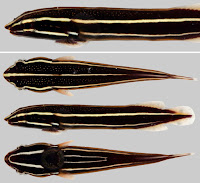 |
| Lepadichthys geminus Fujiwara & Motomura, 2022 |
Abstract
The Lepadichthys lineatus complex (Gobiesocidae: Diademichthyinae) is defined by three unique characters within Lepadichthys: (a) upper-jaw lip fused with snout skin, usually lacking a distinct groove between the dorsal lip margin and snout (if present, very weak, restricted to posterior portion of jaw); (b) snout tip well extended, distinctly beyond lower-jaw tip; and (c) inner surface of both lips with oral papillae. A taxonomic review of the complex recognized four valid species: Lepadichthys geminus sp. nov. (southern Japan and Indonesia), Lepadichthys heemstraorum sp. nov. (southwestern Indian Ocean), Lepadichthys polyastrous sp. nov. (southwestern Indian Ocean) and L. lineatus Briggs, 1966 (Red Sea, Arabian Sea, Seychelles and Sri Lanka). L. geminus and L. lineatus are distinct from L. heemstraorum and L. polyastrous in having a circular (vs. elliptical) disc and more posteriorly located anus [L. geminus and L. lineatus with disc length and width 15.0–18.7 (mean 16.9) and 12.9–16.5 (14.6) % LS, respectively, and length to width ratio 1.03–1.25 cf. L. heemstraorum and L. polyastrous, 17.0–21.5 (18.9) and 11.6–15.2 (13.0) % LS, respectively, and 1.26–1.61; pre-anus length and disc to anus length 65.1–73.6 (68.7) and 25.7–31.6 (28.6) % LS, respectively vs. 60.2–68.3 (65.3) and 21.6–28.9 (25.5) % LS, respectively]. Body depth (as % of LS) is also useful to distinguish L. geminus and L. polyastrous from L. heemstraorum and L. lineatus [viz., 12.7–16.1 (14.4) in L. geminus and 10.8–14.9 (13.1) in L. polyastrous vs. 15.0–17.1 (15.9) in L. heemstraorum and 14.6–18.9 (16.8) in L. lineatus]. L. geminus differs distinctly from other species in the complex as follows: snout tip directed upward, usually on same horizontal level with lower margin of eye lens (lateral view) (vs. directed somewhat downward, horizontal level usually between lower margins of eye and eye lens in L. heemstraorum and L. lineatus, lower margin of eye in L. polyastrous); and lower abdomen with two yellow stripes (vs. a single stripe along ventral midline in L. polyastrous and L. lineatus, unknown in L. heemstraorum). L. polyastrous has unique patterns of yellow dots on the dorsal and ventral body surfaces, forming c. six to eight and three to five longitudinal rows, respectively [vs. usually forming c. three to five longitudinal rows and a single broken line, respectively, in L. geminus and L. lineatus; yellow dots usually absent in L. heemstraorum]. A poorly known species, Lepadichthys caritus Briggs, 1969, is regarded as a junior synonym of L. lineatus.
 |
| Fresh holotype of Lepadichthys geminus sp. nov. (KAUM–I. 145214, 22.3 mm LS, Okinoerabu Island, Amami Islands, Japan). |
The Lepadichthys lineatus complex
Lepadichthys geminus sp. nov.
New English name: Pacific Doubleline Clingfish;
standard Japanese name: Tasuji-umishida-ubauo
Etymology. The specific name “geminus” is derived from Latin, meaning “twin” or “double,” in reference to the two yellow stripes under the abdomen and the close morphological similarity of the new species to L. lineatus, with which it had previously been identified.
Lepadichthys heemstraorum sp. nov.
New English name: Heemstra's Clingfish
Etymology. The specific name “heemstraorum” is in honour of an esteemed ichthyologist, the late Dr Phil Heemstra, who with his wife Elaine Heemstra collected type specimens of L. heemstraorum and L. polyastrous.
Lepadichthys polyastrous sp. nov.
New English name: Starry Clingfish
Etymology. The specific name “polyastrous,” a combination of the New Greek “polys” and “astrous,” means “many stars,” in reference to the many characteristic yellow dots on the body.
Lepadichthys lineatus Briggs 1966
English name: Doubleline Clingfish
Kyoji Fujiwara and Hiroyuki Motomura. 2022. Review of the Lepadichthys lineatus complex (Gobiesocidae: Diademichthyinae) with Descriptions of Three New Species. Journal of Fish Biology. 100(1); 62-81. DOI: 10.1111/jfb.14919
